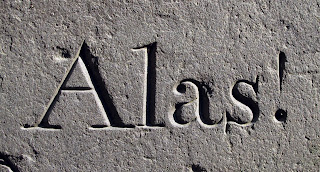This is a fragment

The slate headstones of Nottinghamshire and Leicestershire are the glories of their churchyards. Much of the stone came from the quarries of Swithland in Leicestershire, which were worked until the later 19th century. The headstones are a nuisance to the incumbents of the churches, getting in the way of the machines that cut the grass neatly but often score the surface of the stones as they hit them; the sheep which browse in some country graveyards are a gentler and more effective alternative. Where they are not wholly destroyed, gravestones are dealt with in various ways: often by uprooting them and setting them against a wall, or by laying them flat so the mower can pass over them. One of the more devilishly practical solutions to the problems they pose is not only to lay the stones flat but to make a dry and convenient path to the church door with them.
None of these actions has much to recommend it. Slate, set upright so that it drains naturally, is resistant to weathering, and its grain permits the cutting of fine detail. It withstands even the acid rain of urban environments which eats away the limestones that are also used for gravestones. Uprooting the stones and placing them against a wall tears them away from association with the original graves they were set to mark. Laying them flat allows water to penetrate, so that as it freezes the stone is shattered into its natural layers. Worst of all, when they are used as paving stones, not only does the damp penetrate but the fine and delicate surface is destroyed by the accumulated grit that is pounded into it, grinding away the detail. It takes an insensitive personality to be indifferent to such treatment.
This is a fragment of a headstone from a churchyard in Nottinghamshire which had become a paving stone. It measures about 18 by 13 inches. It is a fragment because it appears to have been quite deliberately reduced to a quarter or less of its original size by blows from a heavy hammer which have removed from it the name and the dates of the person it was designed to commemorate and they have also truncated the verse that had been cut below.

We shall never know the name. As for the verse, with a glance at similar examples one can guess how it may have read:

When I first saw the stone I was distressed by the sight of the damage, and by the erosion of the design that was already visible and which would continue if it was left to lie where I found it. I went into the church. I forget what I said, but it got the result I least expected. The hapless verger (or whatever he was – possibly even the incumbent) asked if I would like to take it away and look after it. It was staggeringly heavy. But somehow I got it back home and it now stands safely upright, as it had done originally, with what is left of its beautifully-cut message washed clean by the rain and often lit by sunshine.
That was a long time ago. Should I have accepted the offer? I do not think I could have removed a stone which still bore the name of a parishioner who had lived nearby, but it seemed to be worth doing something to preserve this anonymous fragment. Although I shall not name the church, I see that its current web page offers admiring tributes to the few, widely-spaced tombs that have been allowed to stay in its churchyard, and even has the temerity to praise their lettering. An image posted on Flickr in 2008 shows that the path to the door of the church is still made up of incised slate headstones.
The church must do what it can to look after itself, but it seems to me that there is a more wide-ranging and worthwhile question to be asked. Why, since by common consent this lettering belongs to a tradition of such quality, have letter-cutters let it die out?
I don’t want to see a flood of weak pastiches of the original vernacular idiom. (The work of Gill’s contemporaries, and of his pupils too, are reminders to us that there were very few who could ever string the bow of Odysseus.) But I should be glad to see some evidence in the work of modern artists that they are aware that we have a durable legacy from the date of this fragment from Nottinghamshire, which I guess to be about 1760, the period of the work of the letter-cutter, typefounder and printer, John Baskerville.

